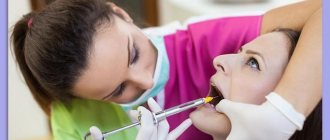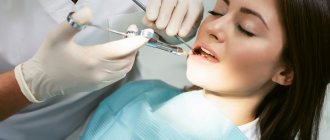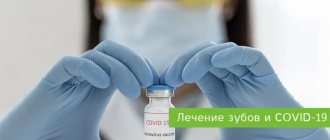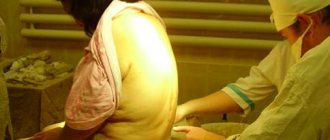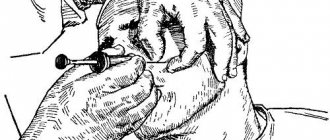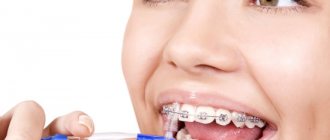Local anesthesia in dentistry: types and preparations
In therapeutic and surgical dentistry, various types and techniques of pain relief are used. These include conduction, intracanal, intraligamentous, etc. They differ in the place of application of the anesthetic and the characteristics of administration, as well as the duration of the effect.
In modern dental clinics, carpule anesthesia is used: the anesthetic is supplied in disposable carpules - cartridges in which painkillers are mixed in the required proportions. They are inserted into syringes with screw-on disposable needles. This makes it possible to ensure sterility, since the doctor does not need to open the containers - contact of the drug with air is excluded.
Conductor
Conduction anesthesia is designed to temporarily block the nerve that transmits the pain signal. This makes it possible to numb several teeth at once, since the sensitivity of a certain area of the jaw is lost. This type of anesthesia is used in cases where it is necessary to remove or treat 2-3 teeth located nearby. It is also used for operations on soft tissues. This anesthesia lasts for at least one and a half hours.
Application anesthesia
Application anesthesia is a type of non-injection anesthesia. Apply the product with your finger or a cotton swab to the selected area. Absorbing into soft tissues to a depth of 3 mm, the medicine can reduce their sensitivity for a short period of time. Most often, this method is used to make the injection painless.
There is another form of drug release - in the form of an aerosol. However, such drugs are used less frequently because there is a possibility of inhalation and the components entering the bloodstream.
Infiltration
There are two types: direct (introduction of the drug under the mucous membrane near the teeth), indirect (introduction into the surrounding tissues). In the first case, the effect is more local, in the second, a larger area is anesthetized.
Infiltration anesthesia is often used for the teeth of the upper jaw. The alveolar processes have a less dense structure, so anesthesia is effective within one hour. In most cases, this is quite enough to perform many procedures, such as treating deep caries, filling root canals, etc.
Intraligamentary
It is also called intraligamentous. This anesthesia differs in that when administering the drug, the doctor applies more pressure so that the drug can be distributed in the periodontal tissues and penetrate into the intraosseous space. This type of pain relief begins to work in less than a minute. However, its effect is short-lived: up to 30 minutes. The administration of the medicine is practically painless, and there is no numbness of the soft tissues. Intraligamentous anesthesia can be used for the extraction and preparation (grinding) of teeth.
Spongy
Also called intraosseous anesthesia, one of the most complex types. It is used when other methods demonstrate ineffectiveness or are impossible. Allows you to anesthetize the process of removing molars and perform interventions on the alveolar processes. The doctor first dissects the mucous membrane and makes a small hole in the bone tissue using a dental bur. Afterwards, a needle is inserted into it, and the anesthetic medicine is supplied to the spongy substance of the jaw. This anesthesia lasts for up to one hour.
General anesthesia in dentistry
General anesthesia in dentistry is used when long-term, serious treatment is necessary. This solution is relevant in cases that require the removal of several teeth at once, or complex interventions on the jaw. An indication for the use of anesthesia can also be a strong fear of the dentist and the upcoming manipulations. It is also advisable to resort to anesthesia if the patient cannot adequately interact with the doctor, for example, in the presence of a neuropsychiatric disease, epilepsy, etc.
An alternative to anesthesia is sedation: it can be used as a way to improve mood, relieve anxiety, and get rid of the fear of medical manipulation. The patient is conscious, but half asleep. Sedation promotes calm, psycho-emotional balance, and normal perception of the specialist’s actions. But this is not pain relief, so this method is combined with local anesthesia.
Injection equipment for local dental anesthesia ru:12659
Injection equipment for local dental anesthesia The safety and effectiveness of local anesthesia in dentistry primarily depends on the equipment used for injection.
Injection equipment must meet the following requirements:
Cause minimal trauma to the patient.
Accurately deliver the anesthetic solution to the destination and create an anesthetic depot.
Precisely dose the anesthetic (up to 0.1 ml).
In dentistry today, various syringes are used that make it possible to perform both traditional anesthesia and intraligamentary, intraosseous, needle-free jet anesthesia, etc.
The injector most suitable for the use of modern carpule anesthetics is the carpule syringe.
Reusable carpule syringes are made of metal (stainless steel, titanium, etc.). We have also mastered the production of plastic carpule syringes - disposable and reusable.
The carpule syringe should be:
compatible with needles from different companies;
strong enough to administer anesthetics under pressure;
have an aesthetic appearance, be simple and convenient to use with one hand;
ensure an aspiration test.
A metal carpule syringe consists of a body 1 and a rod 2, which can have different shapes. As a rule, the body is cylindrical in shape with a window and has a side groove 4 (for placing the carpule). On the body there is a removable tip with nipple 3, with a thread for fixing (screwing on) the needle, two holders 6 (for the index and middle finger of the right hand) The holders can be either flat or in the form of rings. Rod 2 is made in the form of a rod with a plunger 8 at one end and a holder (ring) 7 (for the thumb of the right hand) at the second. The plunger can be in the form of a harpoon or “fungus”, or a hook and provides fixation of the carpule piston plug to ensure its reverse motion during an aspiration test.
If an anesthetic is accidentally introduced into a vessel, the toxicity of the anesthetic solution increases 10 times or more (especially if there is adrenaline in the anesthetic solution), and the patient experiences a general toxic reaction. Therefore, to prevent intravascular injection of an anesthetic, an aspiration test (test) is performed: before injecting the anesthetic solution, the syringe plunger must be pulled towards you. If the aspiration test is positive, you need to pull back the needle, then push it forward again.
Selecting a carpule syringe:
The injector should be simple and easy to use with one hand (the holder for the thumb of the right hand should be in the form of a ring).
There should be a window on the injector body to monitor the use of anesthetic and aspiration sample.
There should be a plunger at the end of the syringe plunger for performing an aspiration test.
The removable tip must have a threaded nipple for fixing different needles and the “American system”).
A cartridge syringe from Truewin Industries (Pakistan) meets all these requirements. The syringe is intended for local anesthesia in dentistry. The design of the syringe allows you to press on the rod and pull it back during aspiration with one hand. Truewin Industries Syringe Optimizes Aspiration Sample with Dual Locking Ring
The kit includes 2 replaceable nozzles for carpule needles according to American and European standards. To replace the carpule, it is necessary to pull the pusher back to its original position.
Very simple, reliable design, three ring-shaped finger grips. Made from particularly light alloy. Its coating is resistant to corrosion. The convenience of using this syringe lies in the fact that the anesthetic cartridge is installed into it very simply. Compatible with all standard cartridges (1.8 ml) with rubber piston. The rotating cartridge holder allows you to see the cartridge in any situation, especially when performing an aspiration test or monitoring the volume of injected solution. Simple disassembly of the syringe makes it easy to clean and sterilize the instrument.
Preparing the carpule syringe for use:
Sterilization of the injector in disassembled form (in an autoclave or in a dry-heat sterilizer, or “cold” sterilization). Sterilization by chemical means is carried out by complete immersion in a solution.
Sterilization of carpules. The carpule is wiped with gauze soaked in a 70° alcohol solution. It is necessary to properly process the rubber plugs.
The cartridge is inserted into the injector body
Press the injector piston so that the plunger is securely fixed in the piston plug of the carpule for carrying out an aspiration test
Select a sterile removable tip so that the thread of its nipple matches the thread of the desired needle. Remove the plastic cap from the rear (short) end of the needle and insert it into the nipple hole, at the same time screw the needle cone onto the injector nipple
Remove the plastic cap from the long end of the needle, pressing the syringe plunger, check the patency of the needle (drops of anesthetic appear at the end of the needle). The carpule syringe is ready for use
To carry out effective intraligamentary (infiltration) and intrapulpal anesthesia, special injectors are used, which create high pressure during injection. They also have a dispenser that ensures that a precisely defined amount of anesthetic is introduced into the tissue when pressing on the syringe lever.
Truewin Industries (Pakistan) injector, shaped like a pistol
This is a universal injector for all types of infiltration anesthesia with minimal doses of anesthetic, using a standard cartridge. Injects a small amount (on average 0.2 ml) of anesthetic per “click”, allowing for a slow, atraumatic injection. One injection is sufficient for intraligamentary anesthesia. Made from high grade stainless steel
The injector kit includes:
two removable tips for different types of carpule needles (European and American systems);
a protective cylinder for the carpule (made of plastic), it is put on the carpule before injection to prevent injury to the patient from glass fragments in case of possible rupture of the carpule during injection.
Preparing the injector for anesthesia:
The injector, replacement tips, protective cylinder and cartridge are sterilized.
A protective cylinder is put on the carpule and inserted into the removable tip (the thread of the nipple of the removable tip must correspond to the type of carpule needle - European or American system).
Screw the needle body onto the nipple of the removable tip, which, in turn, is fixed in the injector body.
Remove the plastic cap from the end of the needle, press the lever (trigger) - drops of anesthetic appear at the end of the needle. The injector is ready for use.
The shape of the injector is very convenient for anesthesia. One injection (0.2 ml of anesthetic) is sufficient for intraligamentary anesthesia into dense dental gums, and 0.4 ml of anesthetic (2 injections) qualitatively anesthetizes a single-rooted tooth with paraapical administration of the drug under the periosteum.
Needles for carpule syringes
Advances in science have led to needles becoming strong, flexible and sharp. These are disposable needles, which reduces the risk of infection entering the body and cross-contamination of the patient(s).
The carpule needle consists of a metal needle itself and a plastic connecting coupling (cone). The long end of the needle (for introducing anesthetic into the tissue) ends with a cut, the short end serves to pierce the carpule plug. The sharpness of the final cut of the needle allows you to minimize the pain of the injection.
The best companies put a mark (dot) on the outside of the cone with red paint on the cut side of the needle tip, which allows better orientation during anesthesia (when directing the cut of the needle to the bone).
Needles are divided by length into “long” (from 28.9 to 41.5 mm) and “short” (from 10 to 25.5 mm). Most companies produce standard needles with lengths of 12, 16, 25, 35, 38 mm
On the inside of the plastic cone there is a thread for screwing the needle onto the carpule syringe. The size (shape) of the cone depends on the type of needle: “European system” or “American system”.
Length, diameter of carpule needles in European and American systems:
Carpule needles are placed in a plastic case. During sterilization, a paper seal or control cut is applied, which seals the package. Needles are packed in a box of 100 pieces. The label indicates the name and address of the company, the type of needle, its length, the outer diameter (number) of the needle, the date of manufacture, and the shelf life. For example: 0.30x21 mm (diameter and length of the needle), 01.2015 (shelf life), Sopira (name of the manufacturer).
The use of carpule needles provides high-quality local anesthesia with minimal pain. It is better to buy needles in batches (packages). It is recommended to use needles only from well-known companies that guarantee high quality products.
A new brand in the field of dental anesthesia - SOPIRA needles (Heraeus Kulzer) - is a combination of many years of experience with the latest developments.
Precision, functionality and reliability are the high standard for SOPIRA carpule needles. The needles are characterized by first-class steel and an innovative needle cut. This solution meets all the requirements of a wide range of forms of dental anesthesia.
A special silicone coating makes it easier for the needle to penetrate the tissue.
Plastic connector with thread and needle bevel orientation indicator allows you to select the optimal direction of needle entry into tissue during injection
The triangular bevel of the needle tip helps reduce pain during injection.
The needles are compatible with all types of dental syringes on the dental market
The use of carpule needles from little-known and dubious companies can lead to complications (possible needle obstruction; fracture near the needle cone during anesthesia). In addition, the needle may not be sharp enough, which will lead to severe pain during the injection and injury to the periosteum.
The commercialization of the activities of dentists is increasingly increasing the requirements for anesthesia. In recent years, effective anesthesia has become a kind of calling card for a private practitioner. The complex that makes up the modern technology of local anesthesia, providing the dentist with effective and safe actions, is:
reliable modern anesthetics and vasoconstrictors
effective methods of local anesthesia
knowledge and practical skills on the full range of issues related to local anesthesia
reliable and convenient instruments (syringes and needles)
#Anesthesia
Ukr-Medmarket 5699 • 01/20/2015
+ Add article
New. Automatic heat press for all types of nylons. Cashless payment. Works with cartridges
24,500 UAH $ 873.13 • € 766.82
Satovsky.Igor.Alexandrovich. • KhersonMore details
When anesthesia is not used:
Contraindications to general anesthesia in dentistry are divided into relative and absolute. The first category includes exacerbation of chronic diseases, infectious diseases (Flu, herpes virus infection, etc.), pregnancy.
Anesthesia is absolutely contraindicated in the following cases:
- heart failure;
- serious kidney and liver diseases;
- endocrine disorders;
- respiratory problems, etc.
Therefore, preparation for general anesthesia is more serious: you will first need to undergo a comprehensive examination and consult with a general practitioner to assess your health and readiness for such a procedure.
Contraindications to anesthesia in dentistry
Anesthesia in dentistry has some contraindications: allergic reactions to anesthetic components, individual intolerance. Side effects are mainly associated with the components of the solutions - vasoconstrictors, or vasoconstrictors, as well as stabilizers and preservatives. Therefore, the doctor is especially careful when choosing an anesthetic for patients with chronic diseases: endocrine, cardiovascular. Preference is given to drugs in which vasoconstrictor components are present in minimal quantities or are absent altogether.
To determine an allergic reaction, a preliminary examination by an allergist may be required. Based on the results of diagnosis and allergy testing, the specialist selects a safe local anesthetic. If reactions are observed to all local agents, general anesthesia may be used.
Potentiated local anesthesia and premedication
Local anesthetics do not affect the emotional and autonomic components of pain, which causes the patient loss of appetite, sleep disturbance, fear, noticeable anxiety (screaming, crying, etc.), fearfulness, irritability, and also affects changes in various organs and systems Local anesthetics do not affect the emotional and autonomic components of pain, which causes the patient to lose appetite, sleep disturbance, fear, noticeable anxiety (screaming, crying, etc.), fearfulness, irritability, and also affects changes in various organs and systems. - the glucocorticoid function of the adrenal cortex increases, blood pressure and body temperature increase, hemodynamics change, etc. This led to the use of premedication , i.e. medications that eliminate the previously listed changes in the patient’s body and improve the performance of surgery under local anesthesia. Potentiation of local anesthesia is an enhancement of the pharmacological action of the anesthetic by other substances, more significant than the summation of the separate effects of these drugs.
Neuroleptanalgesia (neuroleptics + analgesia) is a method of pain relief based on the combined use of neuroleptic drugs and narcotic analgesics. Neuroleptic drugs are medicinal substances that have an inhibitory effect on the functions of the central nervous system, without disturbing consciousness, and can eliminate delusions, hallucinations and some other symptoms of psychosis. Neuroleptics include the following drugs: aminazine, etapyrazine, haloperidol, droperidol, etc. Narcotic analgesics include omnopon, codeine, morphine, promedol, fentanyl, etc. Ataralgesia (ataractics - tranquilizers + analgesics) is a state of depression of consciousness and pain sensitivity caused by combined the action of analgesics and tranquilizers. Tranquilizers, unlike neuroleptic drugs, do not have a pronounced antipsychotic effect. Tranquilizers include the following drugs: elenium, relanium (sibazon, seduxen), phenazepam, mezepam (rudotel), meprobamate, trioxazin, grandaxin, etc. Based on what was said earlier, we present some schemes of neuroleptanalgesia and ataralgesia that have found application in maxillofacial surgery in hospital and clinic settings. Premedication according to the schemes of A.A. Tsiganiy • Children aged 1 year to 8-10 years are administered calypsol (at a dose of 5 mg/kg) and atropine (0.1 mg/kg or 0.1 ml of 1% solution per 10 kg) in the ward ) and taken to the operating room on a gurney. • For children aged 7 to 15 years, premedication at night may not be prescribed, because they do not realize the seriousness of the upcoming operation. In the morning, 30-60 minutes before surgery, 0.1 ml of a 0.1% atropine solution is injected intramuscularly. In the presence of mental agitation or pain (with insufficient local anesthesia), ketamine is additionally administered intramuscularly at the rate of 5 mg/kg in the operating room. • Patients aged 15 years and older on the eve of surgery in the evening and at 6.00 am are prescribed the following drugs: phenobarbital (0.15 mg/kg), diazepam (Seduxen) - 0.15 mg/kg, pipolfen - 0.5 mg/kg. 60 minutes before surgery, a 1% solution of atropine (0.1 mg/kg), seduxen (Sibazon) - 0.2 mg/kg, 1% solution of diphenhydramine (0.4 ml per 10 kg), fentanyl (0.02 mg) is administered intramuscularly. /kg) or 1% morphine solution (0.2 mg/kg). • Patients over 15 years of age with heart defects and diseases and with an increased coronary risk are prescribed: the night before (at 22.00) and in the morning (6.00) sleeping pills (phenobarbital - 0.5-1 mg/kg or noxiron - 1.5 mg), antipsychotics ( pipolfen - 0.5 mg/kg), tranquilizers (seduxen - 0.05-0.15 mg/kg), narcotic analgesics (1% morphine solution - 0.1 mg/kg or 2% promedol solution - 0.2 mg/kg or 0.005% fentanyl solution - 0.01 mg/kg). - in the morning, 60 minutes before surgery, a 1% solution of atropine (0.1 mg/kg), Seduxen or Relanium (0.2 mg/kg), a 1% solution of morphine (0.2 mg/kg) or a 2% solution is administered intramuscularly promedol (0.4 mg/kg) or 0.005% fentanyl solution (0.02 mg/kg) - in the presence of arterial hypertension, patients are additionally prescribed weak antihypertensive drugs (papaverine, dibazole) intramuscularly. Premedication according to the scheme I.A. Shugailova 1 hour before surgery, the following are administered intramuscularly: seduxen at the rate of 0.2 mg per 1 kg of patient weight, droperidol at the rate of 0.1 mg/kg in combination with 0.5-1.0 ml of 0.1% atropine solution.
The result is patient calm, general relaxation, and a state of easily interrupted sleep throughout the operation. This premedication has a normalizing effect on all components of the pain response, which makes it possible to perform the operation under local anesthesia in a hospital setting. A.A. Timofeev Guide to maxillofacial surgery and surgical dentistry Published by Konstantin Mokanov


